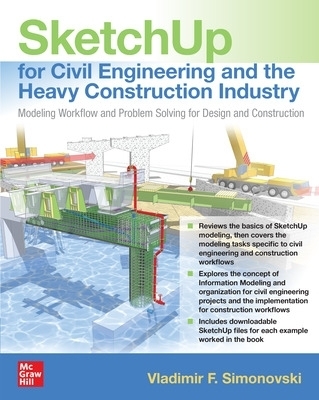
SketchUp for Civil Engineering and the Heavy Construction Industry: Modeling Workflow and Problem Solving for Design and Construction
McGraw-Hill Education (Verlag)
978-1-260-46038-4 (ISBN)
Save schedule time and cost by utilizing SketchUp and Information Modeling and Organization for civil engineering projects in the heavy construction industry
This comprehensive guide showcases an easy to follow workflow methodology for incorporating SketchUp in day-to-day activities during the design and construction phases of civil engineering projects. The book concentrates on the idea of Information Modeling and Organization for projects from the heavy construction industry with richly illustrated and highly detailed real-world examples.
SketchUp for Civil Engineering and the Heavy Construction Industry: Modeling Workflow and Problem Solving for Design and Construction explores the efficient way to convert 2D construction plans into a 3D model that can be used for planning, clash detection (problem identification prior to start of construction), field guidance, work plan creation and visualization support during meetings. The reader will become familiar with the following:
Introduction to Information Modeling and Organization
Introduction to report generation based on the concept of information modeling
SketchUp core tools, supplementary applications, menus, properties and many other aspects of the software
3D modeling of bridge components, terrain modeling, utilization of survey data for 3D models, utilization of CAD files for the purpose of 3D modeling, and more
Workflow examples for creation of 3D models for clash detection purposes by incorporating different components (rebar, post-tensioning, drainage system, fire suppression system, girders, formwork, etc.)
Creation of dynamic components, especially useful for construction equipment
Utilization of SketchUp models for field management use, file sharing, revisions, and more
Introduction to styles and how to make your 3D models intriguing
Introduction
CHAPTER 1 Introduction to SketchUp
The SketchUp Concept
Welcome Screen and Templates
SketchUp Application Window
Tools and Toolsets
Components and Groups
CHAPTER 2 SketchUp and Resources
3D Warehouse
Extension Warehouse and Extensions
Web-Based Resources
CHAPTER 3 Importing Files, AutoCAD, and SketchUp
Importing Files
Overview—AutoCAD Files and SketchUp
Importing Issues with AutoCAD Files
Importing AutoCAD Files to SketchUp
Part 1—Importing of AutoCAD Files
Layers (Tags), Scenes, and Proper Setup of AutoCAD Files in SketchUp
Part 2—Proper Setup of AutoCAD Files
CHAPTER 4 Introduction to Information Modeling and Organization
CHAPTER 5 Modeling of Substructure Components
Pier Footing
CHAPTER 6 Modeling of Steel Reinforcement
Reinforcement Bar Sizes
Stirrup Bend Modeling
Section 1—Stirrup Modeling
Section 2—Create a Stirrup Component
Section 3—Pairing of Reinforcement Bars
Modeling a Steel-reinforced Concrete Pier
Modeling Tips for Reinforcement Drawings
CHAPTER 7 Modeling of Various Bridge Components and Accessories
Post-tensioning Components
Modeling of Anchorage
Post-tensioning Spiral Reinforcement Bar (Bursting Steel)
Layout of Post-tensioning Ducts and Creation of the Entire Unit
Modeling Work
Drainage and Fire Suppression Components
Drainage Elbow
Modeling of Parapet Wall
Formwork Components
Organization Steps
Organizational Workflow Example
CHAPTER 8 Modeling of Bridge Decks and Girders
Modeling of Noncomplex Bridge Decks
Modeling of Complex Bridge Decks
Modeling of Girders
Steel Girders
CHAPTER 9 Site Modeling and Use of Site Creation Tools
Importing of Geo-location Data
Introduction to Sandbox Tools and Terrain Creation
Three-Dimensional Terrain Modeling
Utilization of Terrain Models
CHAPTER 10 Modeling of Construction Mechanization
Modeling of Construction Equipment and Range of Movement
Dynamic Components and Construction Equipment
CHAPTER 11 Styles Inspection Window
Select Submenu
Edit Submenu
Mix Submenu
CHAPTER 12 Introduction to Scenes, Section Cuts, Shadow, and Fog
Scenes
Section Cuts
Section Plane Tool
Shadow Tool
Fog Tool
Index
| Erscheinungsdatum | 16.08.2021 |
|---|---|
| Zusatzinfo | 300 Illustrations |
| Verlagsort | OH |
| Sprache | englisch |
| Maße | 188 x 236 mm |
| Gewicht | 631 g |
| Themenwelt | Technik ► Bauwesen |
| ISBN-10 | 1-260-46038-X / 126046038X |
| ISBN-13 | 978-1-260-46038-4 / 9781260460384 |
| Zustand | Neuware |
| Informationen gemäß Produktsicherheitsverordnung (GPSR) | |
| Haben Sie eine Frage zum Produkt? |
aus dem Bereich


